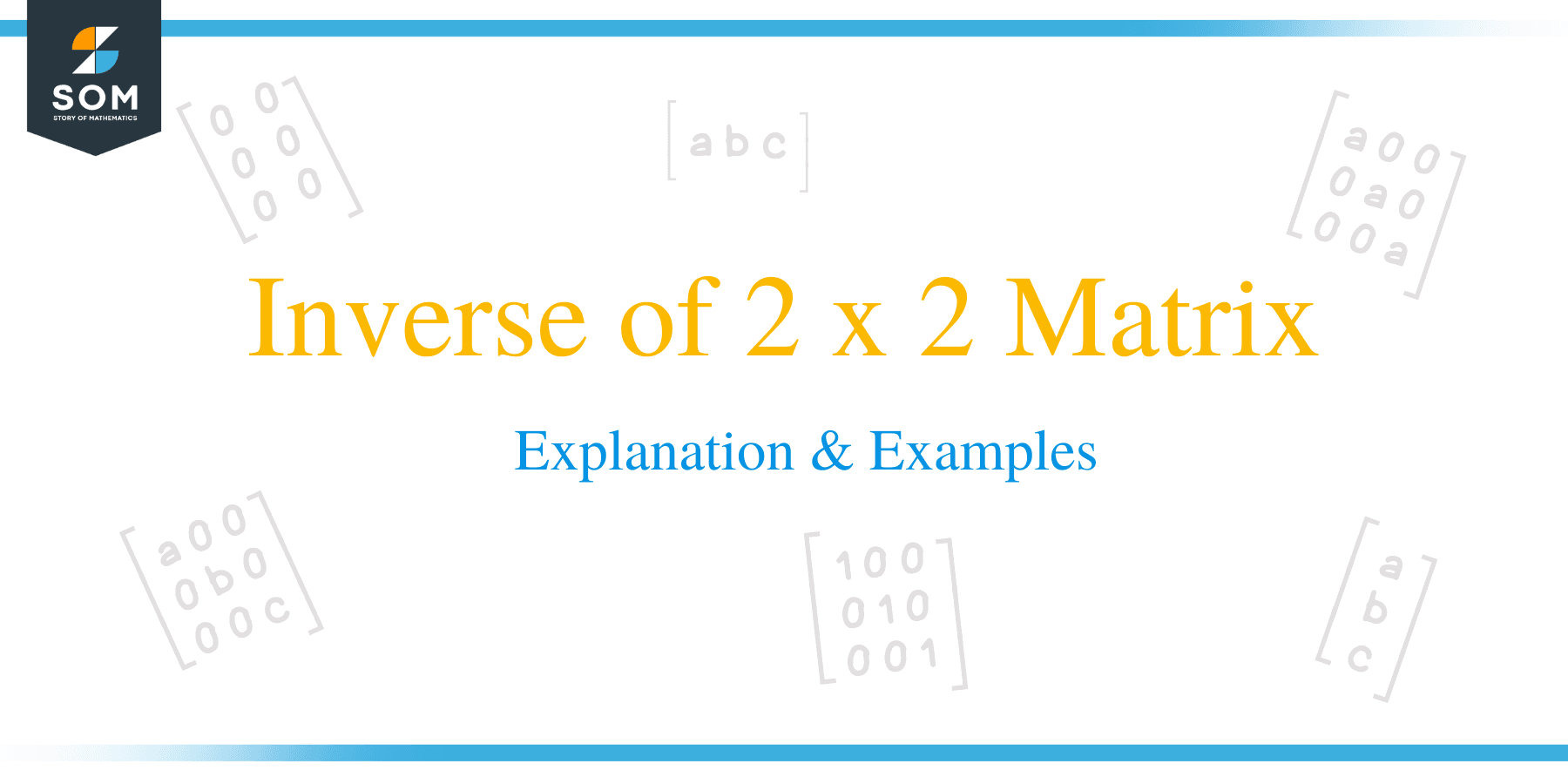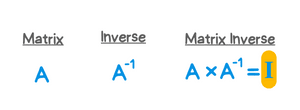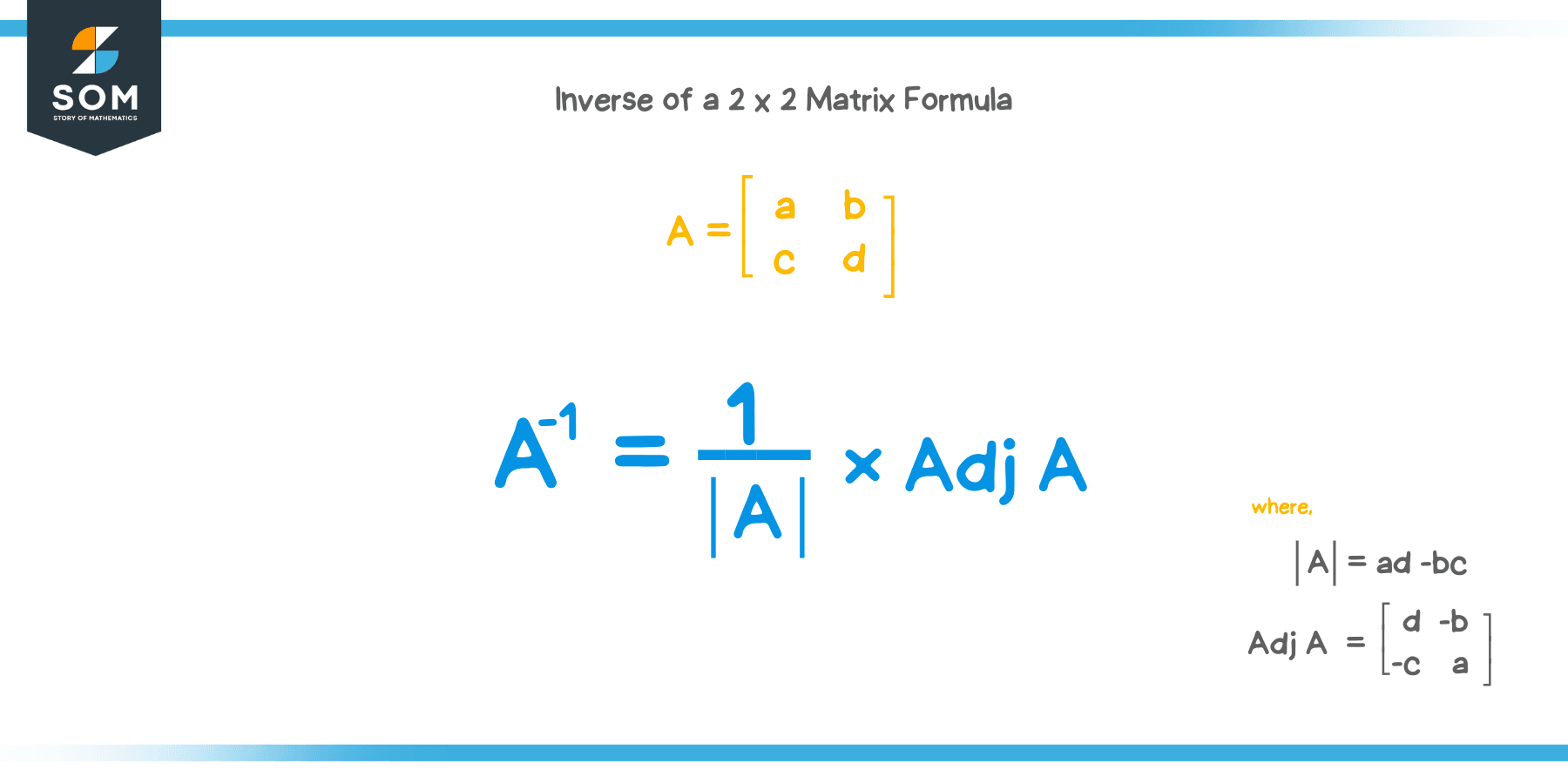- Home
- >
- Inverse of 2×2 matrix – Explanation & Examples
JUMP TO TOPIC
Inverse of 2 x 2 Matrix – Explanation & Examples
 The inverse of a matrix is significant in linear algebra. It helps us solve a system of linear equations. We can find the inverse of square matrices only. Some matrices do not have inverses. So, what is the inverse of a matrix?
The inverse of a matrix is significant in linear algebra. It helps us solve a system of linear equations. We can find the inverse of square matrices only. Some matrices do not have inverses. So, what is the inverse of a matrix?
The inverse of a matrix $ A $ is $ A^{ – 1 } $, such that multiplying the matrix with its inverse results in the identity matrix, $ I $.
In this lesson, we will take a brief look at what an inverse matrix is, find the inverse of a $ 2 \times 2 $ matrix, and the formula for the inverse of a $ 2 \times 2 $ matrix. There will be a lot of examples for you to look at. Practice problems will follow. Happy learning!
What is the Inverse of a Matrix?
In matrix algebra, matrix inverse plays the same role as a reciprocal in number systems. Inverse matrix is the matrix with which we can multiply another matrix to get the identity matrix (the matrix equivalent of the number $ 1 $)! To know more about the identity matrix, please check here.
Consider the $ 2 \times 2 $ matrix shown below:
$ A = \begin{bmatrix} { a } & { b } \\ { c } & { d } \end {bmatrix} $
We denote the inverse of this matrix as $ A^{ – 1 } $.

The multiplicative inverse (reciprocal) in the number system and the inverse matrix in matrices play the same role. Also, the identity matrix ($ I $ ) (in matrices domain) plays the same role as the number one ( $ 1 $ ).
How to Find the Inverse of a 2 x 2 Matrix
So how do we find the inverse of a $ 2 \times 2 $ matrix?
To find the inverse of a matrix, we can use a formula that requires a few points to be satisfied before its usage.
For a matrix to have an inverse, it has to satisfy $ 2 $ conditions:
- The matrix needs to be a square matrix (the number of rows must be equal to the number of columns).
- The determinant of the matrix (this is a scalar value of a matrix from a few operations done on its elements) must not be $ 0 $.
Remember, not all matrices that are square matrices have an inverse. A matrix whose determinant is $ 0 $ is not invertible (doesn’t have an inverse) and is known as a singular matrix.
Read more about singular matrices here!
We will look at a nifty formula for finding the inverse of a $ 2 \times 2 $ matrix below.
2 x 2 Inverse Matrix Formula
Consider the $ 2 \times 2 $ matrix shown below:
$ A = \begin{bmatrix} { a } & { b } \\ { c } & { d } \end {bmatrix} $
The formula for the inverse of a $ 2 \times 2 $ matrix (Matrix $ A $) is given as:
$ A^{ – 1 } = \frac{ 1 }{ad – bc} \begin{bmatrix} d & { – b } \\ { – c } & a \end {bmatrix} $
The quantity $ ad – bc $ is known as the determinant of the matrix. Read more about the determinant of $ 2 \times 2 $ matrices here.
In other words, to calculate the inverse, we interchange $ a $ and $ d $, negate $ b $ and $ c $, and divide the result by the determinant of the matrix!
Let’s calculate the inverse of a $ 2 \times 2 $ matrix ( Matrix $ B $ ) shown below:
$ B = \begin{bmatrix} { 4 } & { – 2 } \\ { 3 } & { – 4 } \end {bmatrix} $
Before we calculate the inverse, we have to check the $ 2 $ conditions outlined above.
- Is it a square matrix?
Yes, it is a $ 2 \times 2 $ square matrix!
- Is the determinant equal to $ 0 $?
Let’s calculate the determinant of Matrix $ B $ by using the determinant formula for a $ 2 \times 2 $ matrix.
$ det( B ) = | B | = \begin{vmatrix} { 4 } & { – 2 } \\ { 3 } & { – 4 } \end {vmatrix} $
$ = ( 4 ) ( – 4 ) – ( – 2 ) ( 3 ) $
$ = – 16 + 6 $
$ = – 10 $
The determinant isn’t $ 0 $. So, we can go ahead and calculate the inverse using the formula we just learned. Shown below:
$ B^{ – 1 } = \frac{ 1 }{ad – bc} \begin{bmatrix} d & { – b } \\ { – c } & a \end {bmatrix} $
$ B^{ – 1 } = – \frac{ 1 }{ 10 } \begin{bmatrix} { – 4 } & { 2 } \\ { – 3 } & { 4 } \end {bmatrix} $
$ B^{ – 1 } = \begin{bmatrix} { \frac{ 4 }{ 10 } } & { – \frac{ 2 }{ 10 } } \\ { \frac{ 3 }{ 10 } } & { – \frac{ 4 }{ 10 } } \end {bmatrix} $
Note: In the last step, we multiplied the scalar constant, $ – \frac{1}{10} $, with each element of the matrix. This is the scalar multiplication of a matrix.
Let’s reduce the fractions and write the final answer:
$ B^{ – 1 } = \begin{bmatrix} { \frac{ 2 }{ 5 } } & { – \frac{ 1 }{ 5 } } \\ { \frac{ 3 }{ 10 } } & { – \frac{ 2 }{ 5 } } \end {bmatrix} $
Let us look at some examples to enhance our understanding further!
Example 1
Given $ C = \begin{bmatrix} { – 10 } & { – 5 } \\ { 6 } & { – \frac{ 2 }{ 5 } } \end {bmatrix}$, find $C^{ – 1 }$.
Solution
We will use the formula for the inverse of a $ 2 \times 2 $ matrix to find the inverse of Matrix $ C $. Shown below:
$ C^{ – 1 } = \frac{ 1 }{ad – bc} \begin{bmatrix} d & { – b } \\ { – c } & a \end {bmatrix} $
$ C^{ – 1 } = \frac{ 1 }{( -10 )( – \frac{ 2 }{ 5 } ) – ( – 5 )(6)} \begin{bmatrix} -1 & 2 \\ 3 & 1 \end {bmatrix} $
$ C^{ – 1 } = \frac{1}{4 + 30}\begin{bmatrix} { – \frac{ 2 }{ 5 } } & { 5 } \\ { – 6 } & { – 10 } \end {bmatrix} $
$ C^{ – 1 } = \frac{1}{34}\begin{bmatrix} { – \frac{ 2 }{ 5 } } & { 5 } \\ { – 6 } & { – 10 } \end {bmatrix} $
$ C^{ – 1 } = \begin{bmatrix} { – \frac{ 1 }{ 85 } } & { \frac{ 5 }{ 34 } } \\ { – \frac{ 3 }{ 17 } } & { – \frac{ 5 }{ 17 } } \end {bmatrix} $
Example 2
Given $ A= \begin{bmatrix} 0 & { – 4 } \\ { – 1 } & 1 \end {bmatrix} $ and $ B= \begin{bmatrix} -\frac{ 1 }{ 4 } & -1 \\ -\frac{ 1 }{ 4 } & 0 \end {bmatrix}$, confirm if Matrix $ B $ is the inverse of Matrix $ A $.
Solution
For Matrix $ B $ to be the inverse of Matrix $, A $, the matrix multiplication between these two matrices should result in an identity matrix ($ 2 \times 2 $ identity matrix). If so, $ B $ is the inverse of $ A $.
Let’s check:
$ A\times B= \begin{bmatrix} 0 & { – 4 } \\ { – 1 } & 1 \end {bmatrix} \times \begin{bmatrix} -\frac{ 1 }{ 4 } & -1 \\ -\frac{ 1 }{ 4 } & 0 \end {bmatrix} $
$ = \begin{bmatrix} (0)(-\frac{1}{4}) + (-4)(-\frac{1}{4}) & (0)(-1) + (-4)(0) \\ (-1)(-\frac{1}{4}) + (1)(-\frac{1}{4}) & (-1)(-1) + (1)(0) \end {bmatrix} $
$ = \begin{bmatrix} { 1 } & { 0 } \\ { 0 } & { 1 } \end {bmatrix} $
This is the $ 2 \times 2 $ identity matrix!
Thus, Matrix $ B $ is the inverse of Matrix $ A $.
If you want to review matrix multiplication, please check this lesson out!
Practice Questions
Given $ A = \begin{bmatrix} { \frac{ 1 }{ 2 } } & { – \frac{ 1 }{ 2 } } \\ { \frac{ 3 }{ 2 } } & { \frac{ 1 }{ 12 } } \end {bmatrix} $, find $A^{ – 1 } $.
- Given $ B = \begin{bmatrix} { – 4 } & { 12 } \\ { – 2 } & { 6 } \end {bmatrix}$, find $B^{ – 1 } $.
- Find the inverse of matrix $ C $ shown below:
$ C = \begin{bmatrix} { 2 } & { 1 } \\ { – 2 } & { 2 } \\ { 1 } & 7 \end {bmatrix} $ - Given $ J = \begin{bmatrix} 1 & { 3 } \\ { – 2} & – 10 \end {bmatrix} $ and $ K = \begin{bmatrix} \frac{ 5 }{ 2 } & \frac{ 4 }{ 3 } \\ – \frac{ 1 }{ 2 } & – \frac{ 1 }{ 4 } \end {bmatrix} $, confirm if Matrix $ K $ is the inverse of Matrix $ J $.
Answers
We will use the formula for the inverse of a $ 2 \times 2 $ matrix to find the inverse of Matrix $ A $. Shown below:
$ A^{ – 1 } = \frac{ 1 }{ad – bc} \begin{bmatrix} d & { – b } \\ { – c } & a \end {bmatrix} $
$ A^{ – 1 } = \frac{ 1 }{( \frac{ 1 }{ 2 } )( \frac{ 1 }{ 12 } ) – ( – \frac{1}{2} )(\frac{ 3 }{ 2 })} \begin{bmatrix} \frac{ 1 }{ 12 } & \frac{ 1 }{ 2 } \\ – \frac{ 3 }{ 2 } & \frac{ 1 }{ 2 } \end {bmatrix} $
$ A^{ – 1 } = \frac{ 1 }{ \frac{ 1 }{ 24 } + \frac{ 3 }{ 4 } } \begin{bmatrix} \frac{ 1 }{ 12 } & \frac{ 1 }{ 2 } \\ – \frac{ 3 }{ 2 } & \frac{ 1 }{ 2 } \end {bmatrix} $
$ A^{ – 1 } = \frac{1}{\frac{ 19 }{ 24 } } \begin{bmatrix} \frac{ 1 }{ 12 } & \frac{ 1 }{ 2 } \\ – \frac{ 3 }{ 2 } & \frac{ 1 }{ 2 } \end {bmatrix} $
$ A^{ – 1 } = \frac{ 24 }{ 19 } \begin{bmatrix} \frac{ 1 }{ 12 } & \frac{ 1 }{ 2 } \\ – \frac{ 3 }{ 2 } & \frac{ 1 }{ 2 } \end {bmatrix} $
$ A^{ – 1 } = \begin{bmatrix} \frac{ 2 }{ 19 } & \frac{ 12 }{ 19 } \\ – \frac{ 36 }{ 19 } & \frac{ 12 }{ 19 } \end {bmatrix} $
- This matrix does not have an inverse.
Why?
Because its determinant is equal to $ 0 $!Recall that the determinant cannot be $ 0 $ for a matrix to have an inverse. Let’s check the value of the determinant:
$ | B | = ad – bc = ( – 4 )( 6 ) – ( 12 )( -2 ) = – 24 +24 = 0 $
Thus, this matrix will not have an inverse!
- This matrix does not have an inverse as well. Recall that only square matrices have inverses! This is not a square matrix. It is a $ 3 \times 2 $ matrix with $ 3 $ rows and $ 2 $ columns. Thus, we can’t calculate the inverse of Matrix $ C $.
For Matrix $ K $ to be the inverse of Matrix $ J $, the matrix multiplication between these two matrices should result in an identity matrix ($ 2 \times 2 $ identity matrix). If so, $ K $ is the inverse of $ J $.
Let’s check:
$ J\times K = \begin{bmatrix} 1 & { 3 } \\ { – 2} & – 10 \end {bmatrix} \times \begin{bmatrix} \frac{ 5 }{ 2 } & \frac{ 4 }{ 3 } \\ – \frac{ 1 }{ 2 } & – \frac{ 1 }{ 4 } \end {bmatrix} $
$ = \begin{bmatrix} (1)( \frac{ 5 }{ 2 } ) + ( 3 )( – \frac{ 1 }{ 2 }) & ( 1 )(\frac{ 4 }{ 3 } ) + ( 3 )(- \frac{ 1 }{ 4 } ) \\ ( – 2 )( \frac{ 5 }{ 2 } ) + (- 10 )(-\frac{ 1 }{ 2 } ) & (- 2 )(\frac{ 4 }{ 3 } ) + (- 10 )(- \frac{ 1 }{ 4 } ) \end {bmatrix} $
$ = \begin{bmatrix} { \frac{ 5 }{ 2 } – \frac{ 3 }{ 2 } } & { \frac{ 4 }{ 3 } – \frac{ 3 }{ 4 } } \\ { – 5 + 5 } & { – \frac{ 8 }{ 3 } + \frac{ 5 }{ 2 } } \end {bmatrix} $
$ = \begin{bmatrix} { 1 } & { \frac{ 7 }{ 12 } } \\ { 0 } & { – \frac{ 1 }{ 6 } } \end {bmatrix} $
This is not the $ 2 \times 2 $ identity matrix!
Thus, Matrix $ K $ is NOT the inverse of Matrix $ J $.
